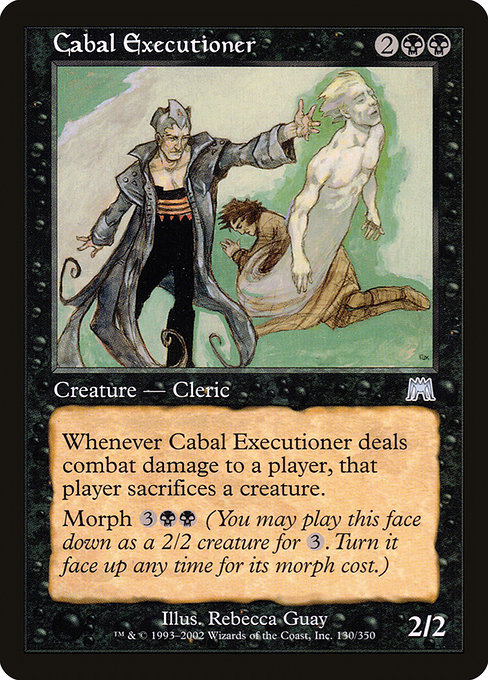
Image courtesy of Scryfall.com
Color Psychology in MTG Art: The Case of Cabal Executioner
Magic: The Gathering has always been as much about mood as it is about mana. Black cards often lean into themes of sacrifice, secrecy, and power drawn from shadowy corners of the multiverse 🧙♂️. Cabal Executioner, a creature from the Onslaught era, is a prime study in how art and mechanics work hand in hand to convey a particular psychology of color. With a mana cost of {2}{B}{B}, this Creature — Human Cleric embodies black’s appetite for control through consequence, a visual and mechanical reminder that every swing of the blade has a cost in souls and strategy 🔥.
Set in the Onslaught block (released in 2002), Cabal Executioner is more than a 2/2 body for four mana. Its true power lies in its conditional removal: “Whenever this creature deals combat damage to a player, that player sacrifices a creature of their choice.” This is classic black: leverage pressure—force the opponent to pay with their board state, and do it with a tempo swing that punishes overextension ⚔️. The morph ability—Morph {3}{B}{B}—adds a layer of psychological misdirection. You can cast it face down as a 2/2 and flip it up when the moment feels right, turning a quiet turn into a devastating reveal. The dual nature of the card—imposing inevitability in the attack phase, then masking its true threat behind Morph—captures black’s love for hidden costs and surprise reversals 🎲.
“In black’s aesthetic, power is often a quiet dark thing you can’t quite see until it’s too late.” — MTG flavor, via Cabal Executioner
The artwork, courtesy of Rebecca Guay, reinforces that psychology with a moodier palette and a sense of stillness that becomes menace once the blade is drawn. The figure is shrouded in shadow, the world around seemingly ordinary until the moment of confrontation. That visual restraint—light used to outline threats, shadows swallowing detail—aligns with the color identity: black as a discipline of sacrifice, control, and tactically coercive power. The card’s rarity—uncommon—lends it to players who love the strategic payoff more than flashy finishes, a perfect match for a color that values the quiet, inevitable march toward advantage 💎.
From a gameplay perspective, Cabal Executioner embodies a core black tactic: convert aggression into lasting advantage by dictating the opponent’s resources. If you land a hit with this 2/2 on a mid-to-late board, the opponent must decide what creature to sacrifice, and that choice often reveals their plans. It’s not just about removal; it’s about shaping the battlefield with psychological pressure. In multiplayer formats, that pressure multiplies as each combat step forces a cascading cost on others, turning Cabal Executioner into a tempo driver and a mental game piece as much as a battlefield unit 🧙♂️🔥.
Morph adds another layer of color psychology. The ability to deploy a face-down threat and reveal it when you’re ready is a physical metaphor for black’s themes of hidden power and calculated risk. The morph cost of {3}{B}{B} invites the question: is the threat already there, lurking beneath the surface, waiting for the perfect moment to reveal itself? When you flip Cabal Executioner, you’re not just turning over a card; you’re turning over a narrative moment where fear and fate become literal mechanics ⚔️.
On the collectability side, Cabal Executioner sits among the printings from Onslaught, with art that continues to draw nostalgia from long-time players and new collectors alike. In Scryfall’s market view, the foil version fetches a meaningful premium, reflecting how art, rarity, and iconic black themes sustain interest in older sets. Even if you’re not chasing the most expensive piece in the room, the card’s balance of flavor and function makes it a memorable inclusion for any Commander deck or casual black-focused build. The evergreen charm of black’s archetypes—sacrifice, control, and deception—still resonates, and Cabal Executioner remains a crisp blade in that arsenal 🧩.
As a cultural touchstone, Cabal Executioner reminds us that MTG art is more than decoration; it’s a narrative device that signals what you’re signing up for when you draft or play. The Onslaught era’s skeletal gothic vibe pairs perfectly with color psychology studies: black isn’t about grand displays; it’s about measured risk, moral complexity, and the realization that power often comes with a price tag that isn’t listed in mana curves. The card’s design—2/2 body, a triggered sacrifice, and a Morph option—encourages players to weave strategic gambits into every encounter, making each game feel like a tense negotiation between shadows and steel ⚡️.
For fans who appreciate both the lore and the lore around the lines on the card, Cabal Executioner provides a compact case study in how MTG’s art direction reinforces its mechanical philosophy. It’s a reminder that the most lasting cards are often the ones that quietly demand attention: they don’t scream; they insinuate, then deliver. If you’re chasing that mood at your desk or in your playgroup, pairing a themed desk setup with a vibe-forward accessory can be a surprisingly satisfying extension of the game’s aesthetics 🧙♂️🎨.
And for readers who want to explore more around the intersection of design, economy, and strategy in MTG and beyond, we’ve gathered a few reads from our network that continue the conversation about how visuals, numbers, and narratives shape our practice:
- https://crypto-acolytes.xyz/blog/post/how-to-prosper-on-minecraft-economy-servers/
- https://blog.digital-vault.xyz/blog/post/designing-notion-dashboards-from-templates-to-live-workspaces/
- https://transparent-paper.shop/blog/post/essential-marketing-analytics-dashboards-for-data-driven-growth/
- https://blog.digital-vault.xyz/blog/post/drain-power-mastering-enchantments-and-artifact-interactions-in-mtg/
- https://blog.digital-vault.xyz/blog/post/hidden-synergies-with-lesser-known-cards-nimble-hobbit/
Interested in bringing a touch of that dark, deliberate vibe to your desk? check out a sleek, customized surface that's as grounded in gaming culture as Cabal Executioner is in the dark corners of the Cabal. The product below is a perfect companion for long sessions, letting your setup reflect the same balance of restraint and menace that makes black archetypes so enduring 🧙♂️💎.
Gaming Mouse Pad - Custom 9x7 Neoprene with Stitched Edges
More from our network
- https://crypto-acolytes.xyz/blog/post/how-to-prosper-on-minecraft-economy-servers/
- https://blog.digital-vault.xyz/blog/post/designing-notion-dashboards-from-templates-to-live-workspaces/
- https://transparent-paper.shop/blog/post/essential-marketing-analytics-dashboards-for-data-driven-growth/
- https://blog.digital-vault.xyz/blog/post/drain-power-mastering-enchantments-and-artifact-interactions-in-mtg/
- https://blog.digital-vault.xyz/blog/post/hidden-synergies-with-lesser-known-cards-nimble-hobbit/